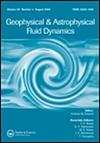在原始变量中旋转浅水的最佳平衡
IF 1.1
4区 地球科学
Q3 ASTRONOMY & ASTROPHYSICS
Geophysical and Astrophysical Fluid Dynamics
Pub Date : 2020-04-02
DOI:10.1080/03091929.2020.1745789
引用次数: 3
摘要
最优平衡是将地球物理流非线性模态分解为平衡和不平衡分量的一种近似最优计算算法。“最优位涡平衡”最早由Viúdez和Dritschel提出。流体机械。基于半拉格朗日位涡的数值编码的具体设置[j] ., 2004, 521, 343。后来,它被认为是慢扰动下快速运动的绝热不变性原理的一个更普遍的例子。从这个角度来看,系统是缓慢变形的,从线性配置到完全非线性动力学。在前者中,线性分析产生平衡和不平衡流动的精确分离。在后者中,可以匹配给定的基点坐标,例如高度或位涡场。这个公式导致了时间上的边值问题。在本文中,我们展示了这种更普遍的观点导致了在原始变量(这里是速度-高度变量)数值代码之上的最佳平衡的实际实现。我们确定了几个设计参数的首选选择。其中最关键的选择是在线性端边界处将线性投影投影到慢模上,在非线性端边界处选择基点坐标。我们发现,即使进化模型是在原始变量中制定的,基于位涡的终点条件是有利的。特别地,唯一普遍鲁棒的线性投影是沿引力波模式投射到罗斯比模上的斜投影,这可以解释为保留线性位涡的罗斯比模上的独特非正交投影。因此,投影仪可以被表述为一个椭圆偏微分方程,它保证了使用该方法对更一般的模型产生精确的非线性模态分解,而不需要求助于渐近分析。本文章由计算机程序翻译,如有差异,请以英文原文为准。
Optimal balance for rotating shallow water in primitive variables
ABSTRACT Optimal balance is a near-optimal computational algorithm for nonlinear mode decomposition of geophysical flows into balanced and unbalanced components. It was first proposed as “optimal potential vorticity balance” by Viúdez and Dritschel [J. Fluid Mech., 2004, 521, 343] in the specific setting of semi-Lagrangian potential vorticity-based numerical codes. Later, it was recognised as an instance of the more general principle of adiabatic invariance of fast degrees of motion under slow perturbations. From this point of view, the system is slowly deformed from a linearised configuration to the full nonlinear dynamics. In the former, linear analysis yields an exact separation of balanced and unbalanced flow. In the latter, a given base-point coordinate, e.g. the height or potential vorticity field, can be matched. This formulation leads to a boundary value problem in time. In this paper, we show that this more general viewpoint leads to practical implementations of optimal balance on top of a primitive variables (here, velocity-height variables) numerical code. We identify preferred choices for several design parameters. The most critical choices concern the linear projector onto the slow modes at the linear-end boundary and the choice of base-point coordinate at the nonlinear end. We find that, even though the evolutionary model is formulated in primitive variables, potential vorticity based end-point conditions are advantageous. In particular, the only universally robust linear projector is the oblique projector onto the Rossby modes along the gravity-wave modes, which can be interpreted as the distinct non-orthogonal projector onto the Rossby modes that preserves the linear potential vorticity. Hence, the projector can be formulated as an elliptic partial differential equation which holds promise for using the method to produce an accurate nonlinear mode decomposition for more general models without the need to resort to asymptotic analysis.
求助全文
通过发布文献求助,成功后即可免费获取论文全文。
去求助
来源期刊

Geophysical and Astrophysical Fluid Dynamics
地学天文-地球化学与地球物理
CiteScore
3.10
自引率
0.00%
发文量
14
审稿时长
>12 weeks
期刊介绍:
Geophysical and Astrophysical Fluid Dynamics exists for the publication of original research papers and short communications, occasional survey articles and conference reports on the fluid mechanics of the earth and planets, including oceans, atmospheres and interiors, and the fluid mechanics of the sun, stars and other astrophysical objects.
In addition, their magnetohydrodynamic behaviours are investigated. Experimental, theoretical and numerical studies of rotating, stratified and convecting fluids of general interest to geophysicists and astrophysicists appear. Properly interpreted observational results are also published.
 求助内容:
求助内容: 应助结果提醒方式:
应助结果提醒方式:


